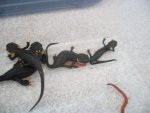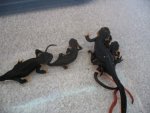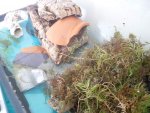mr cyclone
Active member
- Joined
- Mar 14, 2010
- Messages
- 570
- Reaction score
- 38
- Points
- 28
- Location
- Edinburgh Scotland
- Country
- Scotland
Here are my latest arrivals.
I have 6 CB Taliangensis and 2 CB Yangi (or CF Kweichow or kweichow)
I have had these Newts for over a month now, and have been observing them day and night.
I'm housing them in a semi aquatic setup,This setup has lot's of moss on top of cork bark ,which i mist every day/evening.The setup also has a dry area to the left of it so the tylo's can dry out their skin if they choose to do so.
I have noticed the Yangi go for swims very regularly,and are active during the day.These Newts are relatively small at the moment,although they are particularly bold and don't seem to be scared by me at all.The Taliang seem to be slightly more lethargic than the Yangi.I do however see the Taliang out hunting at night and during the day from time to time.
All of the Newts will except earthworms from my hand ,they are all quite bold,which i'm pleased about.The setup they are in at the moment is relatively small ,but it is temporary untill the end of september then they will be transfered to large 19litre food boxes where i will continue to feed them Earthworms and Lesserwaxmoth larvae and they can spend the winter in an unheated room fully terrestrial.
The Taliang seem to go into the water to poop especially straight after the water has been changed lol.Feeding the Newts in this setup is no problem,when the lights are turned off at night the worms emerge from the moss and literally fill the tank they are everywhere!!,Due to the agility of the worms and their slimey secretions they try to escape into the room.I have now built a lid from the original frame of the aquarium with mesh(Stop's the wife going nuts)
All of the Newts seem to be quite healthy,there are however 2 of them that need a little fattening up!. I did initially have the 2 skinny Newts housed seperately but they wouldn't eat anything,so i took a gamble and placed them in the Terrarium to try and let them de-stress.This actually paid off and spotted them two days later out during the day hunting and eating worms.
I have 6 CB Taliangensis and 2 CB Yangi (or CF Kweichow or kweichow)
I have had these Newts for over a month now, and have been observing them day and night.
I'm housing them in a semi aquatic setup,This setup has lot's of moss on top of cork bark ,which i mist every day/evening.The setup also has a dry area to the left of it so the tylo's can dry out their skin if they choose to do so.
I have noticed the Yangi go for swims very regularly,and are active during the day.These Newts are relatively small at the moment,although they are particularly bold and don't seem to be scared by me at all.The Taliang seem to be slightly more lethargic than the Yangi.I do however see the Taliang out hunting at night and during the day from time to time.
All of the Newts will except earthworms from my hand ,they are all quite bold,which i'm pleased about.The setup they are in at the moment is relatively small ,but it is temporary untill the end of september then they will be transfered to large 19litre food boxes where i will continue to feed them Earthworms and Lesserwaxmoth larvae and they can spend the winter in an unheated room fully terrestrial.
The Taliang seem to go into the water to poop especially straight after the water has been changed lol.Feeding the Newts in this setup is no problem,when the lights are turned off at night the worms emerge from the moss and literally fill the tank they are everywhere!!,Due to the agility of the worms and their slimey secretions they try to escape into the room.I have now built a lid from the original frame of the aquarium with mesh(Stop's the wife going nuts)
All of the Newts seem to be quite healthy,there are however 2 of them that need a little fattening up!. I did initially have the 2 skinny Newts housed seperately but they wouldn't eat anything,so i took a gamble and placed them in the Terrarium to try and let them de-stress.This actually paid off and spotted them two days later out during the day hunting and eating worms.
Attachments
-
 black tylos 016.jpg83.1 KB · Views: 940
black tylos 016.jpg83.1 KB · Views: 940 -
 black tylos 012.jpg81.5 KB · Views: 1,238
black tylos 012.jpg81.5 KB · Views: 1,238 -
 black tylos 011.jpg65.6 KB · Views: 700
black tylos 011.jpg65.6 KB · Views: 700 -
 black tylos 013.jpg51.8 KB · Views: 715
black tylos 013.jpg51.8 KB · Views: 715 -
 black tylos 009.jpg65.4 KB · Views: 814
black tylos 009.jpg65.4 KB · Views: 814 -
 black tylos 005.jpg100 KB · Views: 598
black tylos 005.jpg100 KB · Views: 598 -
 black tylos 003.jpg159.5 KB · Views: 527
black tylos 003.jpg159.5 KB · Views: 527 -
 black tylos 010.jpg72.5 KB · Views: 1,192
black tylos 010.jpg72.5 KB · Views: 1,192

